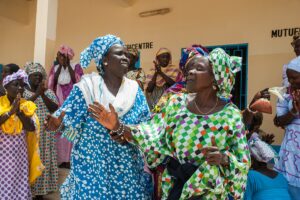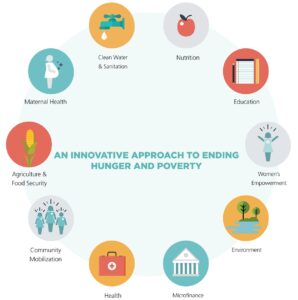Epicenter strategy in Africa
The Hunger Project has been working in partnership with people and leaders in East, West and Southern Africa since 1991 and has developed a cost-effective and easily transferable strategy called the Epicenter Strategy.
This “bottom-up” strategy has proven to be very successful in overcoming hunger and poverty in rural Africa.
Fachtsheet: Epicenter Strategy in Africa
THP Switzerland in Burkina Faso, Ethiopia, Ghana, Mozambique and India.
Dynamic centers
Groups of villages join together to form dynamic centers where they learn to act together to meet their basic needs. They also gain access to previously unknown and/or unused government resources.
The epicenters are located in areas that are far (at least 20 km) from small and large cities, and are thus cut off from health services, schools, markets and often also services provided by other non-governmental organizations.

4 phases in 8 years
The epicenter strategy is divided into four clearly differentiated phases and accompanies people from extreme poverty to a life of independence within about eight years.
The basic attitude of the people, which is initially characterized by dependence, resignation and discrimination against women, is changed by this process. A new attitude based on responsibility, autonomy and gender equality is emerging.
The balance sheet
To date, a total of 121 epicenters have been established in eight African countries, reaching almost two million people and providing them with sustainable improvements in health, education, nutrition and family income.

We are looking for support contributions for the following objectives
- Mobilization of communities
- Equality of women and men
- Food Security
- Education and literacy
- Health and improvement of nutrition
- Clean water
- Hygiene and cleanliness of the environment
- Microfinance to improve family income
- Evaluation of the program success

Epicenter strategy in Africa
The Hunger Project has been working in partnership with people and leaders in East, West and Southern Africa since 1991 and has developed a cost-effective and easily transferable strategy called the Epicenter Strategy.
This “bottom-up” strategy has proven to be very successful in overcoming hunger and poverty in rural Africa.
Fachtsheet: Epicenter Strategy in Africa
THP Switzerland in Burkina Faso, Ethiopia, Ghana, Mozambique and India.
Dynamic centers
Groups of villages join together to form dynamic centers where they learn to act together to meet their basic needs. They also gain access to previously unknown and/or unused government resources.
The epicenters are located in areas that are far (at least 20 km) from small and large cities, and are thus cut off from health services, schools, markets and often also services provided by other non-governmental organizations.

4 phases in 8 years
The epicenter strategy is divided into four clearly differentiated phases and accompanies people from extreme poverty to a life of independence within about eight years.
The basic attitude of the people, which is initially characterized by dependence, resignation and discrimination against women, is changed by this process. A new attitude based on responsibility, autonomy and gender equality is emerging.
The balance sheet
To date, a total of 121 epicenters have been established in eight African countries, reaching almost two million people and providing them with sustainable improvements in health, education, nutrition and family income.

We are looking for support contributions for the following objectives
- Mobilization of communities
- Equality of women and men
- Food Security
- Education and literacy
- Health and improvement of nutrition
- Clean water
- Hygiene and cleanliness of the environment
- Microfinance to improve family income
- Evaluation of the program success


